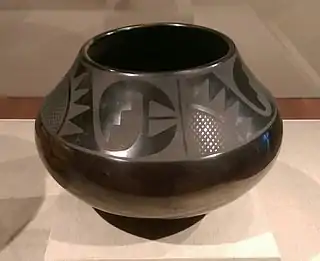Burnishing (pottery)
Burnishing is a form of pottery treatment in which the surface of the pot is polished, using a hard smooth surface such as a wooden or bone spatula, smooth stones, plastic, or even glass bulbs, while it still is in a leathery 'green' state, i.e., before firing.[1] After firing, the surface is extremely shiny.[2]

Tripod vessel with lid, Maya culture, Mexico or Guatemala, c. 4th-5th century, hand-built ceramic with incised decoration and burnished slip, Honolulu Museum of Art, accession 4183.1

A pot by Maria Martinez, approximately 1945, at the de Young Museum in San Francisco
This technique can be applied to concrete masonry, creating a polished finish.[3]
Burnishing can also be applied to wood, by rubbing two pieces together along the grain. Hard woods take the treatment best. Burnishing does not protect the wood like a varnish does, but does impart a glossy sheen.[4]
See also
- Black-burnished ware, a type of Romano-British ceramic
- Black-on-black ware, a pottery tradition developed by Puebloan Native American ceramic artists
- Northern Black Polished Ware of Iron Age India
References
- Von Dassow, Sumi. "Burnishing Pottery: A Step by Step Guide". ceramicartsnetwork.org. The American Ceramic Society. Retrieved 31 August 2020.
- Peterson, Beth. "How to Burnish Pottery". The Spruce Crafts. The Spruce Crafts. Retrieved 31 August 2020.
- "Burnishing Versus Sealing Concrete". customconcreteprepandpolish.com. Custom Concrete Prep & Polish. Retrieved 31 August 2020.
- Burton, Walter E. (1957). Burnishing Puts a Fine Finish on Wood or Metal (108 ed.). Popular Mechanics. p. 205.
This article is issued from Wikipedia. The text is licensed under Creative Commons - Attribution - Sharealike. Additional terms may apply for the media files.